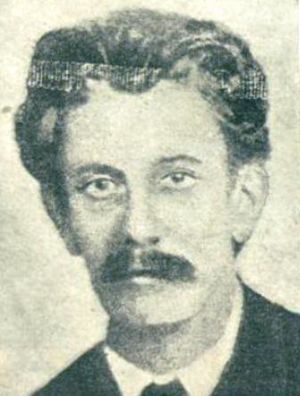Friedrich Adler (politician) facts for kids
Friedrich Wolfgang "Fritz" Adler (born July 9, 1879 – died January 2, 1960) was an Austrian socialist politician. He was also a physicist, philosopher, and journalist. He is known for his strong opposition to World War I. He is perhaps best known for his action against Minister-President Karl von Stürgkh in 1916.
Contents
Early Life and Education
Friedrich Adler was born in Vienna, Austria. His father, Victor Adler, founded the Social Democratic Party of Austria. His mother was Emma Braun. Friedrich followed his father's advice and studied science. He studied chemistry, physics, and mathematics at the ETH Zurich university in Switzerland. There, he became good friends with the famous scientist Albert Einstein.
Starting in Politics
Friedrich Adler joined the Social Democratic Party of Switzerland. In 1897, he also joined the Austrian Social Democrats. He started working as a journalist. In 1910, Adler became an editor for the Volksrecht newspaper in Zurich.
Adler was interested in philosophy, especially the ideas of Ernst Mach. He even wrote about Mach's ideas. He was considered for a physics professor job at ETH Zurich. However, he believed Albert Einstein was more skilled. So, Adler helped Einstein get the position instead.
Adler also worked with international trade unions. In 1911, he stopped his science work. He became the secretary-general of the Social Democratic Party in Vienna. He held this job until 1914. He also edited the magazine Der Kampf with Otto Bauer. Adler became a leader of the party's left wing. When World War I started in 1914, he strongly spoke out against his party's support for the war.
Taking Action Against the War
Friedrich Adler strongly opposed Austria-Hungary's war policies. He felt that the government was not listening to the people. On October 21, 1916, he took a drastic step. In a hotel in Vienna, he shot the Austrian minister-president, Count Karl von Stürgkh. Stürgkh had prevented the Austrian parliament from meeting since 1913. This meant people had no say in the government.
Adler's action caused different reactions. Some called it "strange and incomprehensible." Others, especially outside Austria, saw it as a necessary act against a leader who blocked democracy. Adler was put on trial in May 1917. He used the trial to explain his actions. He said he was fighting against the war and against politicians who supported it. He was sentenced to death. However, Emperor Charles I of Austria changed his sentence to 18 years in prison.
After World War I
Near the end of the war, Emperor Charles I released Adler from prison. As the Austro-Hungarian Monarchy ended, Adler played an important role. He led Arbeiterräte, which were workers' councils. He also became a member of the National Council of Austria.
Even though some wanted him to join the Communist Party, Adler stayed loyal to the Social Democrats. After his father died in November 1918, Friedrich Adler helped form the new Republic of German-Austrian government. He worked with his party friends Otto Bauer and Julius Deutsch to support Karl Renner's government.
Between the World Wars
Karl Seitz became the leader of the Social Democratic Party. The party then worked with the Christian Social Party in a government. Adler became the secretary of the International Working Union of Socialist Parties in 1921. He helped create the Labour and Socialist International. He served as its secretary-general until 1940. During this time, he saw the rise of Nazism in Europe.
The Social Democratic Party was banned in Austria in 1934. This happened after the Austrian Civil War. When Austria became part of Nazi Germany in March 1938, party leaders moved to Brussels and then to Paris.
World War II and Later Years
When World War II started in 1940, the party leaders moved to London. Friedrich Adler moved to New York City in the United States. There, he started the Austrian Labor Committee in 1942.
In 1943, the Allied countries declared that Austria should be free again after the war. Adler, who had different ideas about an Austrian nation, slowly retired from politics.
In 1946, Adler moved back to Europe and settled in Switzerland. He worked on editing letters written by his father, Victor, to other important socialists. He visited Vienna one last time in 1952. This was to celebrate 100 years since his father's birth. He was honored greatly during this visit.
Death and Legacy
Friedrich Adler passed away on January 2, 1960, in his home in Zurich, Switzerland. He was 80 years old.
Images for kids
See also
 In Spanish: Friedrich Adler para niños
In Spanish: Friedrich Adler para niños



